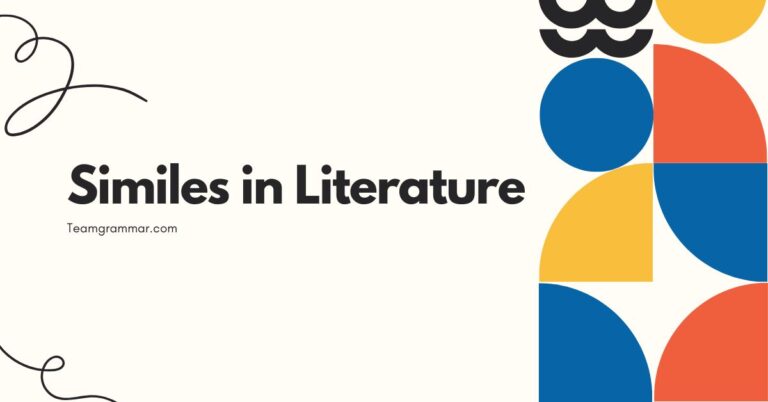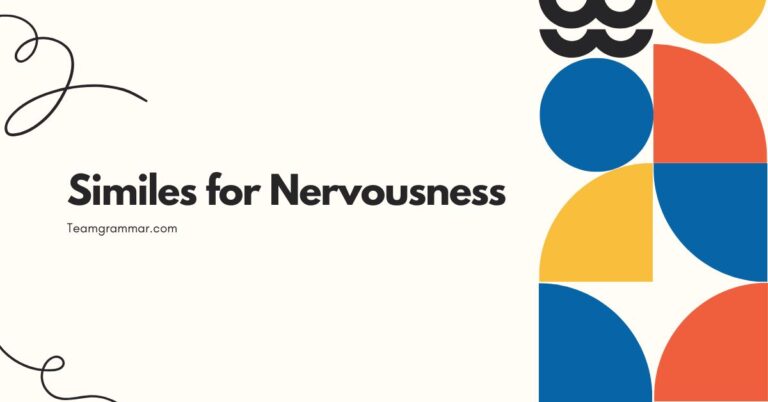38+ Similes for Hot: Mastering Figurative Language
Similes are powerful tools in the English language, allowing us to paint vivid pictures and create impactful descriptions. Understanding and using similes effectively can significantly enhance your writing and speaking skills.
This article focuses specifically on similes used to describe heat, exploring various examples and providing a comprehensive guide to their usage. Whether you’re a student, writer, or language enthusiast, this guide will equip you with the knowledge and practice to confidently use similes for “hot” in your communication.
Table of Contents
- Introduction
- Definition of Similes
- Structural Breakdown of Similes
- Types of Similes
- Examples of Similes for Hot
- Usage Rules for Similes
- Common Mistakes with Similes
- Practice Exercises
- Advanced Topics in Similes
- FAQ Section
- Conclusion
Introduction
Similes are essential components of figurative language, adding depth and vibrancy to our expressions. They allow us to draw comparisons between seemingly unrelated things, creating a richer and more engaging experience for the reader or listener.
The ability to effectively use similes, particularly when describing sensations like heat, showcases a strong command of the English language. This article delves into the world of similes for “hot,” providing a detailed explanation of their structure, usage, and common applications.
By the end of this guide, you’ll be well-equipped to use these similes with confidence and creativity.
Definition of Similes
Asimileis a figure of speech that directly compares two different things, explicitly using the words “like” or “as.” The purpose of a simile is to create a vivid image or convey a specific feeling by associating one thing with another that shares a similar characteristic. Similes are a type of figurative language, which means they are not meant to be taken literally.
Their strength lies in their ability to evoke emotions and enhance understanding through comparison.
Similes are classified as a type ofanalogy, which is a broader term for any comparison between two things. However, similes are more specific because they always use “like” or “as.” They function as descriptive tools, helping to clarify and emphasize certain qualities.
The context in which a simile is used greatly influences its impact. For example, a simile used in poetry will likely have a different tone and purpose than one used in scientific writing.
Structural Breakdown of Similes
The basic structure of a simile consists of three main components: thesubject, thelinking word(“like” or “as”), and theobject of comparison. The subject is the thing being described, and the object of comparison is the thing it’s being compared to.
The linking word explicitly indicates the comparison. Understanding this structure is crucial for creating effective and accurate similes.
For instance, in the simile “The sun was like a furnace,” thesubjectis “the sun,” thelinking wordis “like,” and theobject of comparisonis “a furnace.” This structure clearly shows that the sun’s heat is being compared to the intense heat of a furnace. Variations of this basic structure exist, but the core components remain the same.
For example, you could say, “The sun was as hot as a furnace,” which maintains the same meaning but uses “as” instead of “like.” The key is to ensure the comparison is clear and logical.
Types of Similes
While all similes share the same basic structure, they can be categorized based on their purpose and the type of comparison they make. Understanding these categories can help you choose the most appropriate simile for a given situation.
Here are some common types of similes:
Descriptive Similes
These similes focus on describing a particular quality or characteristic of the subject. They aim to create a vivid image in the reader’s mind by highlighting a specific similarity between the subject and the object of comparison.
For example, “The desert air was as dry as parchment” is a descriptive simile that emphasizes the dryness of the air.
Explanatory Similes
Explanatory similes are used to clarify or explain something by comparing it to something more familiar or easily understood. They help the reader grasp a concept by relating it to something they already know.
For example, “The process was like baking a cake; each step had to be followed carefully” explains the importance of following each step in a process.
Emphatic Similes
Emphatic similes are used to emphasize a particular aspect of the subject. They aim to strengthen the impact of the description by using a comparison that is particularly striking or memorable.
For example, “The heat was like a physical blow” emphasizes the intensity and force of the heat.
Examples of Similes for Hot
This section provides a comprehensive collection of similes specifically designed to describe heat in various contexts. These examples are categorized to help you understand how different similes can be used to convey different nuances of heat, from intense and scorching to mild and pleasant.
Each category offers a range of options to suit your specific descriptive needs.
Similes Describing Intense Heat
These similes are used to describe extreme heat, often associated with discomfort, danger, or overwhelming sensation. They evoke a strong sense of the heat’s intensity and its impact on the surroundings or the person experiencing it.
The following table provides a variety of similes to describe intense heat, each with a slightly different nuance. Consider the context when choosing the most appropriate simile.
| Simile | Explanation |
|---|---|
| As hot as a furnace | Implies intense, industrial heat. |
| Like standing in front of an open oven | Suggests a dry, baking heat. |
| As hot as the sun | Indicates a powerful, radiant heat. |
| Like being trapped in a sauna | Conveys a humid, suffocating heat. |
| As hot as hell | Emphasizes extreme, unbearable heat. |
| Like walking through fire | Suggests a painful, burning heat. |
| As scorching as a desert at noon | Highlights the relentless, dry heat of a desert. |
| Like a blast furnace | Similar to a regular furnace, but even more intense. |
| As fiery as a dragon’s breath | Adds a fantastical element to the description of heat. |
| Like being inside a volcano | Suggests extreme heat and pressure. |
| As sweltering as a tropical jungle | Implies humid and oppressive heat. |
| Like a heatwave rolling over you | Describes the feeling of being overwhelmed by heat. |
| As baking as a brick oven | Highlights the dry, intense heat of a brick oven. |
| Like simmering in a pot | Conveys the feeling of being slowly cooked by the heat. |
| As blazing as a bonfire | Suggests a large, intense fire. |
| Like being under a heat lamp | Describes the feeling of direct, focused heat. |
| As torrid as a summer day in the Sahara | Emphasizes the extreme heat of the Sahara Desert. |
| Like being in a kiln | Suggests a very high, industrial heat. |
| As roasting as a spit over a fire | Implies a slow, intense cooking heat. |
| Like a furnace cranked to maximum | Highlights the highest possible level of heat. |
| As incandescent as a lightbulb filament | Describes a glowing, intense heat. |
| Like standing too close to a welding torch | Suggests a focused, burning heat. |
| As searing as a hot iron | Implies a burning, painful heat. |
| Like a microwave on high | Conveys a quick, intense burst of heat. |
| As volcanic as a lava flow | Highlights the molten, destructive power of lava. |
Similes Describing Moderate Heat
These similes are used to describe a level of heat that is noticeable and perhaps slightly uncomfortable, but not overwhelmingly intense. They can be used to describe a warm day, a heated room, or a mild sensation of heat.
The following table illustrates similes for moderate heat. These comparisons are gentler and more suitable for describing comfortable or slightly uncomfortable warmth.
| Simile | Explanation |
|---|---|
| As warm as a summer breeze | Suggests a pleasant, gentle warmth. |
| Like sitting by a fireplace | Conveys a cozy, comforting warmth. |
| As mild as a spring day | Indicates a gentle, not overpowering heat. |
| Like a warm bath | Suggests a relaxing, soothing warmth. |
| As toasty as a warm blanket | Implies a snug, comforting warmth. |
| Like a gentle hug | Conveys a comforting, embracing warmth. |
| As balmy as a Mediterranean evening | Highlights the pleasant warmth of a Mediterranean climate. |
| Like the sun on your skin | Describes the pleasant sensation of the sun’s warmth. |
| As heated as a cup of tea | Suggests a gentle, comforting warmth. |
| Like the inside of a greenhouse | Conveys a humid, but not overwhelming, warmth. |
| As temperate as a mild climate | Indicates a balanced, comfortable warmth. |
| Like an embrace from the sun | Describes the sun’s warmth in a comforting way. |
| As cozy as a log cabin in winter | Highlights the comforting warmth of a log cabin. |
| Like a warm, sunny afternoon | Suggests a pleasant and relaxing warmth. |
| As agreeable as a heated room | Implies a comfortable and welcoming warmth. |
| Like a baker’s oven | Describes the warm, inviting atmosphere of a bakery. |
| As lukewarm as bathwater | Indicates a gentle, not too hot warmth. |
| Like a heated blanket on low | Suggests a gentle, sustained warmth. |
| As clement as a mild summer day | Highlights the pleasantness of a mild summer. |
| Like sitting in a sunbeam | Describes the direct, comforting warmth of the sun. |
Similes Describing Dry Heat
These similes are used to describe heat that is characterized by a lack of humidity. Dry heat can feel harsh and dehydrating, and these similes aim to capture that sensation.
The following table provides examples of similes that effectively describe dry heat, emphasizing the arid and parching qualities.
| Simile | Explanation |
|---|---|
| As dry as a desert wind | Suggests a parched and arid heat. |
| Like breathing in a hair dryer | Conveys the feeling of hot, dry air. |
| As arid as a kiln | Implies a dry, baking heat. |
| Like standing in a convection oven | Suggests a dry, circulating heat. |
| As parched as sun-baked earth | Highlights the dryness of the earth. |
| Like a furnace without water | Emphasizes the absence of moisture. |
| As desiccated as ancient bones | Highlights the extreme dryness and age. |
| Like being in a sauna with no water | Describes a dry, intense heat without humidity. |
| As sere as a drought-stricken land | Suggests a barren, dry landscape. |
| Like the air in a tanning bed | Conveys a dry, artificial heat. |
| As sapless as a dead tree | Implies a complete lack of moisture. |
| Like breathing desert air | Describes the dry, hot air of a desert. |
| As withered as old leather | Highlights the dry, shrunken texture. |
| Like being baked in a solar oven | Suggests a slow, dry cooking process. |
| As evaporated as a puddle in the sun | Implies a complete disappearance of moisture. |
Similes Describing Humid Heat
These similes are used to describe heat that is accompanied by high humidity. Humid heat can feel heavy, sticky, and oppressive, making it difficult to breathe and causing excessive sweating.
The following table presents similes that effectively describe humid heat, emphasizing the sticky, oppressive, and moisture-laden qualities.
| Simile | Explanation |
|---|---|
| As humid as a rainforest | Suggests a wet, sticky heat. |
| Like walking through soup | Conveys the feeling of dense, moist air. |
| As muggy as a swamp | Implies a heavy, oppressive humidity. |
| Like being wrapped in a wet blanket | Suggests a suffocating, moist heat. |
| As sticky as taffy | Highlights the clinging, uncomfortable feeling. |
| Like breathing underwater | Emphasizes the difficulty of breathing. |
| As steamy as a Turkish bath | Suggests a hot, moist environment. |
| Like being inside a greenhouse | Describes a warm, humid environment. |
| As cloying as a humid night | Implies a heavy, oppressive feeling. |
| Like a sauna at full blast | Conveys intense heat and humidity. |
| As sodden as a sponge | Highlights the saturation with moisture. |
| Like being in a tropical hothouse | Describes a lush, humid environment. |
| As drenched as after a downpour | Highlights the feeling of being soaked. |
| Like the air in a laundry room | Suggests a warm, damp environment. |
| As saturated as a monsoon season | Implies extreme wetness and humidity. |
Figurative Similes for Hot
These similes extend the concept of “hot” beyond literal temperature to describe emotions, situations, or other abstract concepts. They use the association of heat with intensity, passion, or excitement to create a more vivid and impactful description.
The following table contains figurative similes that use the concept of heat to describe emotions, situations, or other abstract ideas. These comparisons add depth and intensity to your descriptions.
| Simile | Explanation |
|---|---|
| As hot as a burning passion | Suggests intense love or desire. |
| Like a fire in his heart | Conveys strong emotions or motivation. |
| As heated as a debate | Implies a passionate and intense argument. |
| Like a volcano about to erupt | Suggests suppressed anger or frustration. |
| As fiery as a rebel’s spirit | Highlights passion and defiance. |
| Like a simmering feud | Conveys a long-standing, unresolved conflict. |
| As torrid as a love affair | Suggests a passionate and intense romance. |
| Like a hotbed of controversy | Describes a situation filled with disagreement. |
| As incandescent as a star | Implies brilliance and intensity. |
| Like a burning question | Conveys a pressing and urgent issue. |
| As fervent as a religious zealot | Highlights strong belief and enthusiasm. |
| Like a hot potato | Describes a controversial or difficult issue. |
| As scorching as a harsh criticism | Highlights the painful impact of criticism. |
| Like a burning ambition | Suggests a strong desire for success. |
| As ardent as a lover’s gaze | Implies intense affection and desire. |
Usage Rules for Similes
Using similes effectively requires adhering to certain rules to ensure clarity and impact. Here are some key guidelines to follow:
- Ensure the comparison is clear and logical: The similarity between the subject and the object of comparison should be obvious and relevant. Avoid comparisons that are too abstract or obscure.
- Choose vivid and specific objects of comparison: The more specific and evocative the object of comparison, the more effective the simile will be. For example, “as hot as the sun” is more impactful than “as hot as something.”
- Avoid clichés: Overused similes can sound unoriginal and lack impact. Strive to create fresh and unique comparisons.
- Consider the context: The appropriateness of a simile depends on the context in which it is used. A simile that works well in poetry might not be suitable for a scientific report.
- Maintain consistency: Ensure that the simile aligns with the overall tone and style of your writing.
Common Mistakes with Similes
Several common mistakes can weaken the effectiveness of similes. Being aware of these errors can help you avoid them and improve your writing.
The following table highlights common mistakes made when using similes, along with corrections and explanations.
| Incorrect | Correct | Explanation |
|---|---|---|
| The heat was like hot. | The heat was like a furnace. | The object of comparison should be specific and evocative. |
| He was as hot as a cucumber. | He was as cool as a cucumber. | Ensure the comparison is logical and makes sense. |
| The sun was like the sun. | The sun was like a giant spotlight. | Avoid comparing something to itself. |
| It was hot like always. | It was as hot as a summer day in July. | Use “like” or “as” correctly to form the simile. |
| The heat was like, really hot. | The heat was like standing in front of an open fire. | Avoid unnecessary words or phrases that weaken the simile. |
Practice Exercises
Test your understanding of similes with these practice exercises. Each exercise focuses on a different aspect of simile usage, from identifying similes to creating your own.
Exercise 1: Identifying Similes
Identify the similes in the following sentences.
| Question | Answer |
|---|---|
| 1. The desert was as hot as an oven. | As hot as an oven |
| 2. Her anger was a fire in her eyes. | (Not a simile – metaphor) |
| 3. The humid air felt like a wet blanket. | Like a wet blanket |
| 4. He ran quickly. | (No simile) |
| 5. The sun was like a giant spotlight. | Like a giant spotlight |
| 6. The coffee was as hot as lava. | As hot as lava |
| 7. The debate was heated. | (No simile) |
| 8. The room felt like a sauna. | Like a sauna |
| 9. She sang beautifully. | (No simile) |
| 10. The criticism was as scorching as the sun. | As scorching as the sun |
Exercise 2: Completing Similes
Complete the following similes with an appropriate object of comparison.
| Question | Answer |
|---|---|
| 1. The heat was as dry as __________. | sandpaper |
| 2. The sun felt like __________. | a warm embrace |
| 3. The air was as humid as __________. | a swamp |
| 4. His temper was as hot as __________. | a volcano |
| 5. The room was like __________. | an oven |
| 6. The coffee was as strong as __________. | rocket fuel |
| 7. The breeze was as warm as __________. | a summer day |
| 8. Her smile was as radiant as __________. | the sun |
| 9. The challenge was as daunting as __________. | climbing Mount Everest |
| 10. The silence was as heavy as __________. | a tomb |
Exercise 3: Creating Similes
Create your own similes to describe the following situations.
| Situation | Example Simile |
|---|---|
| 1. A very hot day | The day was as hot as the surface of Mercury. |
| 2. A heated argument | The argument was like a wildfire, consuming everything in its path. |
| 3. A passionate love | Their love was as hot as a burning flame, impossible to ignore. |
| 4. A dry desert | The desert was as dry as an old bone, cracked and lifeless. |
| 5. A humid jungle | The jungle was as humid as a steam room, thick with moisture. |
| 6. Intense competition | The competition was as fierce as a pack of wolves fighting over prey. |
| 7. A difficult challenge | The challenge was as daunting as climbing a sheer cliff face. |
| 8. Overwhelming sadness | The sadness was as heavy as a lead weight, dragging her down. |
| 9. Unexpected joy | The joy was as radiant as the morning sun, chasing away the shadows. |
| 10. Deep silence | The silence was as profound as the depths of the ocean, vast and unknown. |
Advanced Topics in Similes
For advanced learners, exploring the nuances of similes can further enhance their understanding and usage. Here are some advanced topics to consider:
- Extended Similes: These are similes that are developed over several sentences or paragraphs, creating a more elaborate and detailed comparison.
- Subverted Similes: These are similes that intentionally break the rules or expectations, often for humorous or ironic effect.
- Cultural Variations: The effectiveness of a simile can vary depending on the cultural background of the audience. Understanding these variations can help you communicate more effectively across cultures.
- Similes in Literature: Analyzing how similes are used in different literary genres and by different authors can provide valuable insights into their power and versatility.
FAQ Section
Here are some frequently asked questions about similes:
- What is the difference between a simile and a metaphor?
A simile explicitly compares two things using “like” or “as,” while a metaphor implies a comparison without using these words. For example, “He is like a lion” is a simile, while “He is a lion” is a metaphor.
- Can a simile be used in formal writing?
Yes, similes can be used in formal writing, but they should be used sparingly and with careful consideration of the context. Overuse of similes can make the writing sound less professional.
- How can I avoid using clichés in my similes?
To avoid clichés, try to think of original and unexpected comparisons. Consider the specific qualities you want to emphasize and brainstorm objects or concepts that share those qualities in a unique way.
- Is it possible to use too many similes in a piece of writing?
Yes, it is possible to overuse similes. Too many similes can make the writing feel cluttered and distracting. Use them judiciously to enhance, rather than overwhelm, the description.
- What is the best way to create a strong simile?
The best way to create a strong simile is to choose a specific and vivid object of comparison that clearly highlights the quality you want to emphasize. Consider the emotional impact of the comparison and choose an object that evokes the desired feeling.
- How do I know if my simile is effective?
An effective simile is one that clearly and vividly conveys the intended meaning or feeling. Ask yourself if the comparison is clear, logical, and memorable. If possible, get feedback from others to see how they interpret the simile.
- Are similes only used in creative writing?
No, similes can be used in a variety of contexts, including creative writing, journalism, and even scientific writing. However, their purpose and style may vary depending on the context.
- Can a simile be subjective?
Yes, similes can be subjective, as their effectiveness depends on the reader’s or listener’s interpretation of the comparison. What one person finds vivid and meaningful, another may find confusing or irrelevant. Therefore, it’s important to consider your audience when choosing a simile.
- How do I choose between using “like” or “as” in a simile?
Both “like” and “as” can be used interchangeably in many similes. However, “as” is often used in more formal or literary contexts, while “like” is more common in everyday speech. The choice often comes down to personal preference and the desired tone.
- Can similes be used to describe abstract concepts?
Yes, similes can be effectively used to describe abstract concepts by comparing them to more concrete or familiar things. This can help to make the abstract concept more understandable and relatable.
Conclusion
Mastering the use of similes, especially those describing heat, can significantly elevate your writing and communication skills. By understanding the structure, types, and usage rules of similes, you can create vivid and impactful descriptions that resonate with your audience.
Remember to avoid clichés, choose specific and evocative objects of comparison, and always consider the context in which you are using the simile. With practice and attention to detail, you can confidently use similes to add depth and richness to your language.
Continue to explore and experiment with different similes, and pay attention to how other writers use them effectively. The more you practice, the more natural and intuitive your use of similes will become.
By embracing the power of figurative language, you can unlock new levels of creativity and expressiveness in your writing and speaking.







